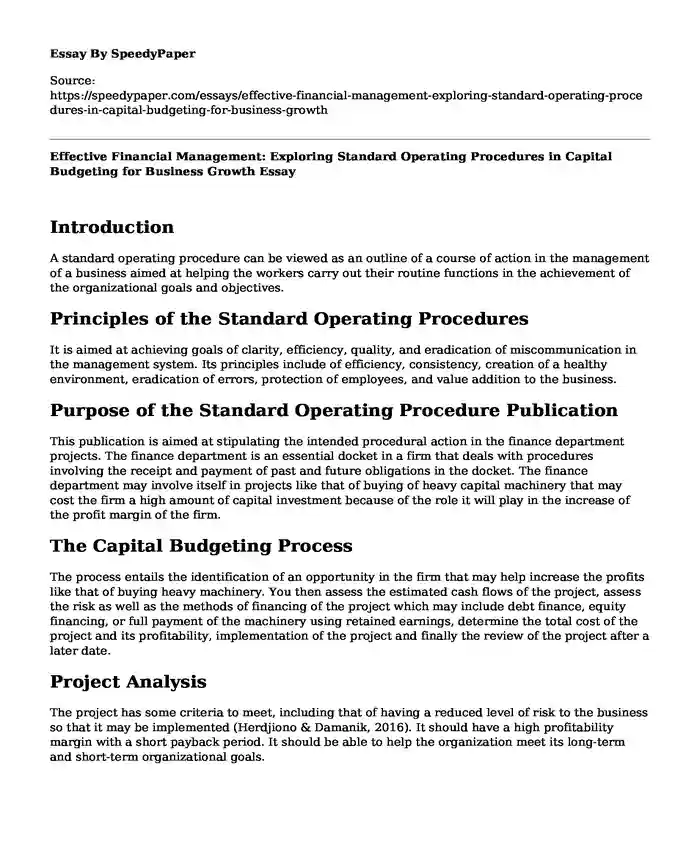
| Type of paper: | Essay |
| Categories: | Business Budgeting Financial management |
| Pages: | 3 |
| Wordcount: | 739 words |
Introduction
A standard operating procedure can be viewed as an outline of a course of action in the management of a business aimed at helping the workers carry out their routine functions in the achievement of the organizational goals and objectives.
Principles of the Standard Operating Procedures
It is aimed at achieving goals of clarity, efficiency, quality, and eradication of miscommunication in the management system. Its principles include of efficiency, consistency, creation of a healthy environment, eradication of errors, protection of employees, and value addition to the business.
Purpose of the Standard Operating Procedure Publication
This publication is aimed at stipulating the intended procedural action in the finance department projects. The finance department is an essential docket in a firm that deals with procedures involving the receipt and payment of past and future obligations in the docket. The finance department may involve itself in projects like that of buying of heavy capital machinery that may cost the firm a high amount of capital investment because of the role it will play in the increase of the profit margin of the firm.
The Capital Budgeting Process
The process entails the identification of an opportunity in the firm that may help increase the profits like that of buying heavy machinery. You then assess the estimated cash flows of the project, assess the risk as well as the methods of financing of the project which may include debt finance, equity financing, or full payment of the machinery using retained earnings, determine the total cost of the project and its profitability, implementation of the project and finally the review of the project after a later date.
Project Analysis
The project has some criteria to meet, including that of having a reduced level of risk to the business so that it may be implemented (Herdjiono & Damanik, 2016). It should have a high profitability margin with a short payback period. It should be able to help the organization meet its long-term and short-term organizational goals.
Expected Rates
The Internal Rate of Return is expected to be at 14% on return to investments. The expected payback period should be short, like three years. This will help the firm make long-term profits using the asset it purchased. The Net Book Value of the investment in question should be high, projecting a low rate of the annual depreciation rate of the machinery.
Project Documentation
The project is expected to be financed using debt-equity, and this will entail the use of collateral. The collateral on the loan will be the land of the firm hence documents like the title deed will be required, the financial statements of the company like the balance sheet and the income statement will also be a requirement as well as the information on cash flow and that of changes in equity before the financing of a loan by a financial institution.
Risk Analysis
The project may involve some risk, including that the machine is faulty, and this can be reduced by buying a machine with a warranty (Nguyen, 2017). The training of the employees on how to use the machine should also be done. The use of insurance to cover various unanticipated risks should also be done.
Portfolio Analysis
The project should be able to meet the long-term and short-term financial goals without necessarily putting the business at risk. It should be able to pay its capital loan as well as make a profit for the company.
The Retained Profit Concern of the Project
The project will ensure that a 4% rollover of the profits (retained earnings) will be used in the implementation of other projects of the firm. This will help maintain a useful profitability index and higher working capital for the firm.
Conclusion
The continued increase in the level of profits of the firm is to be credited to the sound financial management of the firm by the finance department. The use of debt financing in financing the project is necessary so as not to interfere with the liquidity ratio of the firm. It is the role of the finance department to organize the budget and present it to the finance committee of the firm so that it can be approved.
References
Herdjiono, I., & Damanik, L. A. (2016). Pengaruh financial attitude, financial knowledge, parental income terhadap financial management behavior. Jurnal Manajemen Teori dan Terapan| Journal of Theory and Applied Management, 9(3).
Nguyen, D. N(2017). TASK-BASED STANDARD OPERATING PROCEDURE APPROACH TO IMPLEMENT BUSINESS PROCESS MANAGEMENT IN RETAIL.
Cite this page
Effective Financial Management: Exploring Standard Operating Procedures in Capital Budgeting for Business Growth. (2024, Jan 20). Retrieved from https://speedypaper.com/essays/effective-financial-management-exploring-standard-operating-procedures-in-capital-budgeting-for-business-growth
Request Removal
If you are the original author of this essay and no longer wish to have it published on the SpeedyPaper website, please click below to request its removal:
- Essay Sample on How to Improve One's Financial Situation
- Free Essay: LASA Conflict Management Report
- Essay Example on Promotion of the 4Ps
- Essay Example on Amazon's Financial Trend
- Essay Example: Rhode Island Budget
- Paper Example on Advertising Chicken Masala Meal
- Essay Sample on Managing Risks in Information System
Popular categories




